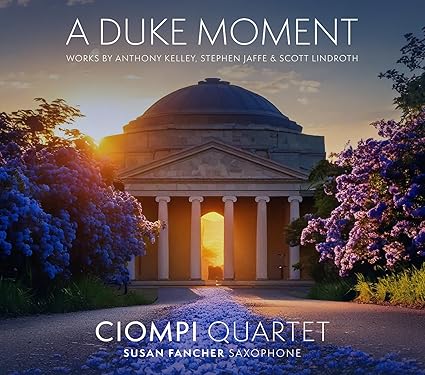The first two pieces are similar in flavor, based on various American styles such as blues, jazz, ragtime etc. The first one of them is a significant work, highly accomplished and much more substantial than the second. While the final work is completely different – almost a saxophone concerto of sorts which doesn’t necessarily quite fit in on a string quartet program featuring the Ciompi Quartet. (More on this when we get there.)
Stephen Jaffe’s 3rd String Quartet (2014) is entertaining and filled with charm from beginning to end. The piece is comprised of 7 fairly short sections – the shortest just 45 seconds; the longest just over 7 minutes. The opening Prelude is coy, almost flirtatious, inviting one to come in and listen. And the rich blend of the Ciompi Quartet keeps us there, immersed in the music in anticipation of what will come next. The pace quickens and soon gives way to a delightful Scherzo, dancing with little hints of jazz here and there. Ribbons is bustling and gossamer, with lovely singing lines above the gently insistent rhythmic propulsion. Night Blues, at just over 7 minutes, is the most substantial and varied, with a nice bluesy feel. While the Postlude is reminiscent of the opening, but soon breaks into a lyrical central section, almost a chorale, before coming to a humble, rather wistful close.
This is highly creative and imaginative, enormously well-crafted, and superbly orchestrated without ever resorting to gimmickry (which has become far too common these days). There are several modern-day contemporary composers I can think of who could (should) learn a thing or two from Mr. Jaffe! This piece is a model of creative musical composition – inspired and imaginative – which can stand firmly on its own merit without the need for endless exploitation of sounds masquerading as music. (I find new music which continually exhibits the composer’s infatuation with inventing new ways of making noise from string instruments as a substitute for real musical creativity just so tiresome.) Jaffe is a master of the miniature for sure. Each of these sections is a real gem – concise and perfectly complete in its brevity – combining to make a pleasing and satisfactory whole. He’s also a master at tunefulness, adding to its appeal. This is an important addition to the string quartet repertoire, excellent even among some of the best new String Quartets I’ve heard recently. And I hope it gains favor with groups everywhere.
Incidentally, the Ciompi Quartet also recorded Jaffe’s 1st String Quartet (though with a different 1st violin and cellist) way back in 1991, on an album of American string quartet music for Albany Records. It is nothing like this newer work. It is rather more substantial than the 3rd, and more determined and decidedly more avant-garde in its structure and deliberate avoidance of tonality. His 2nd Quartet, written over a decade later, and recorded by the Borromeo String Quartet for Bridge Records in 2022, veers away from the formulaic modernism of his 1st, showing the composer maturing into a more inspired, creative, and more distinguished, distinctive voice – which begins to look forward to the more alluring (and approachable) appeal of his 3rd without going that far. It really is a masterpiece which deserves to be better known.
Anthony M. Kelley‘s Sidelines, written in 2008, is very short and rather slight of substance in comparison. It consists of just two brief, sports-themed miniatures, Baseball and Basketball. The first (“A Ragtime Fugue”) is more modern in flavor and less beguiling than Jaffe’s Quartet, but rather more overtly “American” in spirit. I hear more blues than Ragtime – tasteful, almost subtle, in inflection. It lasts barely 3 minutes. The second (“Variation on the Jump”) is shorter still, but very charming, and more overtly African-American flavored in its jazzy influence. Coming in at just over 2 minutes, I wish Mr. Kelley had developed it into something more substantial. Both sections were over much too quickly and I wanted more from this composer.
In the final work, Schley Road, Scott Lindroth adds an alto saxophone to the quartet of strings. At first I welcomed its shimmering, vibrato-rich sound, which added an extra dimension of color and atmosphere. But it didn’t take long before the sax became too domineering. As it goes on, there simply isn’t enough variety in the writing or the scoring to prevent the saxophone from becoming an incessant, unrelenting presence. One longs for a moment of respite where the sax stops playing and the strings take over for some much needed contrast and variety of mood, color and texture. But that never happens. The quartet of strings is relegated entirely to an accompaniment role, and there it remains for the entire 24 minutes, making this feel almost like a saxophone concerto with string quartet accompaniment, which might have been better suited on an album of all saxophone music.
This observation certainly has nothing to do with Susan Fancher’s wonderful playing, which is lovely. I read in the booklet this was commissioned by Fancher in 2019, and initially consisted of just one movement (the 2nd). Later, Mr. Lindroth composed additional music which became the opening movement. I can’t help but think that the original (2nd) movement would have been entirely satisfying as a stand-alone, single-movement work. This composer is obviously very talented and there is a lot of really nice, atmospheric music here – much of it very rewarding.
In the end, I wish the Ciompi Quartet had limited Lindroth to just the one movement and convinced Anthony Kelley to compose a few new sections to add to his earlier piece to fill out the disc. There are certainly a lot more team sports he could have expanded on! I think that might have been just the right amount of saxophone variety on this string quartet program, while giving us the opportunity to hear more of Mr. Kelley’s creativity, which I would have eagerly welcomed. But I enjoyed what we have and this disc is noteworthy – most of all for Jaffe’s 3rd Quartet, which is fabulously entertaining.
Typical of New Focus Recordings, the recorded sound throughout is superb, as is the playing of the wonderful Ciompi Quartet.





